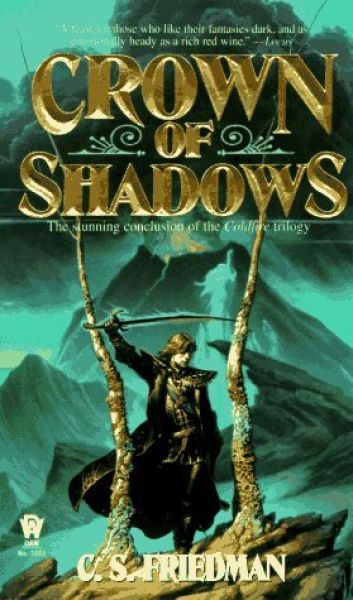And Far Too Old To See
Crown of Shadows (Coldfire, volume 3)
By C. S. Friedman

8 Dec, 2021
0 comments
1995’s Crown of Shadows is the third and final book in C. S. Friedman’s Coldfire science fiction trilogy.
Priest Damien and undead Tarrant return to their respective homes with a much better understanding of the challenges now facing them. On the minus side: many lives (including their own) depend on finding a solution to their problems. On the plus side, there’s a strict time limit. Soon enough it won’t matter what they do.
Given that the demonic Calesta is an existential threat to humans, the logical next step (once Damien returns home) is for the Patriarch of the Church to orchestrate a united front against the demon. The Patriarch’s immediate attention is focused on the alliance between Damien and Tarrant. Since Tarrant is tantamount to Satan as far as the Church is concerned, the Patriarch takes a very dim view of Damien palling around with Tarrant.
Although the Patriarch does not eject Damien from the Church — leaving Damien to accomplish his exit on his own time and for his own reasons — the Patriarch does devote some effort to an alternative strategy for managing the ongoing crisis. Although Tarrant famously slaughtered his own family centuries ago, he spared a single child. There is in the present era a Tarrant descendent alive, Andrys Tarrant and it is to Andrys the Patriarch’s attention turns.
Each demon has an innate weakness. They feed off specific emotional states or phenomena. The opposite of that state is anathema to them. The catch is that it is not always obvious what the opposite. For example, the demon1Karrel lives on pleasure: it might seem like pain would be its Kryptonite but in fact it is apathy. Calesta is a sadist. Precisely what the opposite of sadism is is not immediately obvious.
The opposite of sadism turns out to be altruism. All Tarrant needs to do to end Calesta is sacrifice his own life in the ultimate act of altruism. Nothing could be easier. However, inasmuch as Tarrant became the figure of fear he currently is in pursuit of immortality, such an act seems unlikely.
Tarrant’s desire for life is not the impediment it appears. However, there is another player in the game, a player overlooked by Tarrant’s bold strategy — a player who considers Calesta’s destruction a personal affront and Tarrant’s role in it grounds to use the Neocount in her own scheme.
~oOo~
I can only assume there are a million words of slash fiction about Damian and Tarrant.
Sorry for the poor reproduction of the cover. A high resolution of the cover may be found here.
In the Patriarch’s defense, Calesta isn’t really the primary threat facing the humans, merely a form the threat takes. The real threat is a world mutable by human whim without regard for consequence. Some might elect to make humans better, but — as amusing as Lenin’s vanguard models on a magic-imbued planet might be — the Patriarch elects to take a different direction.
Crown has what I like to unhelpfully call the “I don’t care who killed Boy Staunton” problem. In this case, Tarrant has by his own choice spent a thousand years stalking, terrorizing, and murdering women to feed off their fear. Redemption is not on the books at this point, and the fact he is somewhat useful towards the end of his life isn’t enough to make me care about his fate. However, the book seems to assume the reader won’t feel massive indifference or outright hatred towards him. Perhaps some readers find Tarrant dark and swoony.
On a similar note, I can only agree with Andrys whenever he criticizes himself. In general, the Tarrants’ capacity for self-pity isn’t a sufficient reason to care one way or another about them, except to the extent they’re a threat.
On a sentence level, the writing in this is fine. I just hated the Tarrants.
This volume was a bit overlong for the story it wanted to tell, a reflection of the era in which it was written. Somewhat after the rise of work processors, which facilitated the production of very long manuscripts, but before 2003, when Barnes & Noble and Borders announced they would no longer purchase lengthy mid-list SF2 novels, long works like this were perfectly acceptable. I prefer leaner more direct story-telling but perhaps your milage varies.
Crown of Shadows is available here (Amazon US), here (Amazon Canada), here (Amazon UK), here (Barnes & Noble), here (Book Depository), and here (Chapters-Indigo).
1: Technically, Calesta is an Iezu but Iezu are close enough to demons that they may be regarded as such … until an actual demon comes along.
2: “SF?” you say under my narrative compulsion, “Isn’t this fantasy, given the demons and what not?” The mechanism behind the fae is just as Sfnal as Dune’s clairvoyant navigators, The Void Captain’s Tale’s orgasmic FTL drives, and Get Off the Unicorn’s Talents.
